2013 NISSAN QUEST brakes
[x] Cancel search: brakesPage 2 of 27
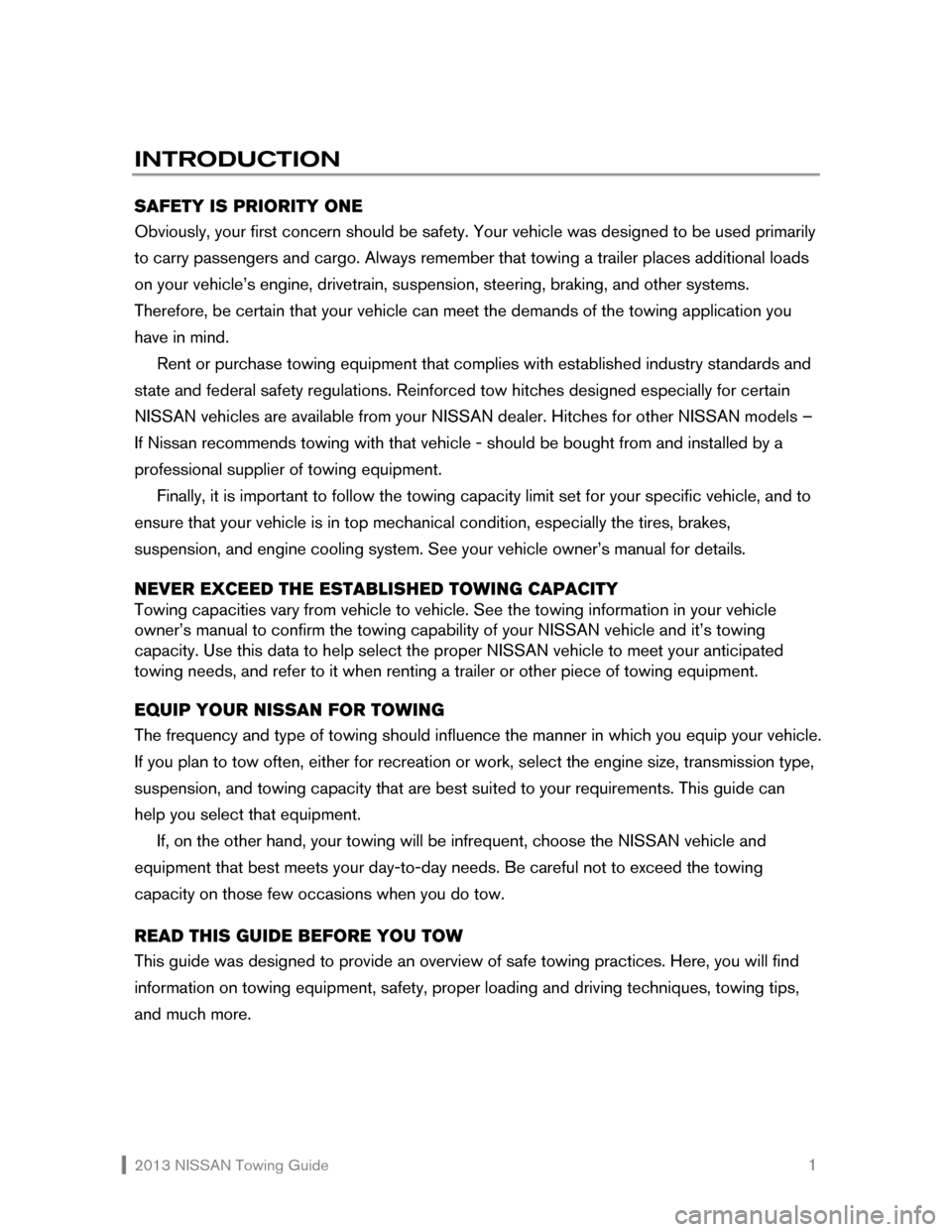
2013 NISSAN Towing Guide 1
INTRODUCTION
SAFETY IS PRIORITY ONE
Obviously, your first concern should be safety. Your vehicle was designed to be used primarily
to carry passengers and cargo. Always remember that towing a trailer places additional loads
on your vehicle’s engine, drivetrain, suspension, steering, braking, and other systems.
Therefore, be certain that your vehicle can meet the demands of the towing application you
have in mind.
Rent or purchase towing equipment that complies with established industry standards and
state and federal safety regulations. Reinforced tow hitches designed especially for certain
NISSAN vehicles are available from your NISSAN dealer. Hitches for other NISSAN models –
If Nissan recommends towing with that vehicle - should be bought from and installed by a
professional supplier of towing equipment.
Finally, it is important to follow the towing capacity limit set for your specific vehicle, and to
ensure that your vehicle is in top mechanical condition, especially the tires, brakes,
suspension, and engine cooling system. See your vehicle owner’s manual for details.
NEVER EXCEED THE ESTABLISHED TOWING CAPACITY
Towing capacities vary from vehicle to vehicle. See the towing information in your vehicle
owner’s manual to confirm the towing capability of your NISSAN vehicle and it’s towing
capacity. Use this data to help select the proper NISSAN vehicle to meet your anticipated
towing needs, and refer to it when renting a trailer or other piece of towing equipment.
EQUIP YOUR NISSAN FOR TOWING
The frequency and type of towing should influence the manner in which you equip your vehicle.
If you plan to tow often, either for recreation or work, select the engine size, transmission type,
suspension, and towing capacity that are best suited to your requirements. This guide can
help you select that equipment.
If, on the other hand, your towing will be infrequent, choose the NISSAN vehicle and
equipment that best meets your day-to-day needs. Be careful not to exceed the towing
capacity on those few occasions when you do tow.
READ THIS GUIDE BEFORE YOU TOW
This guide was designed to provide an overview of safe towing practices. Here, you will find
information on towing equipment, safety, proper loading and driving techniques, towing tips,
and much more.
Page 3 of 27
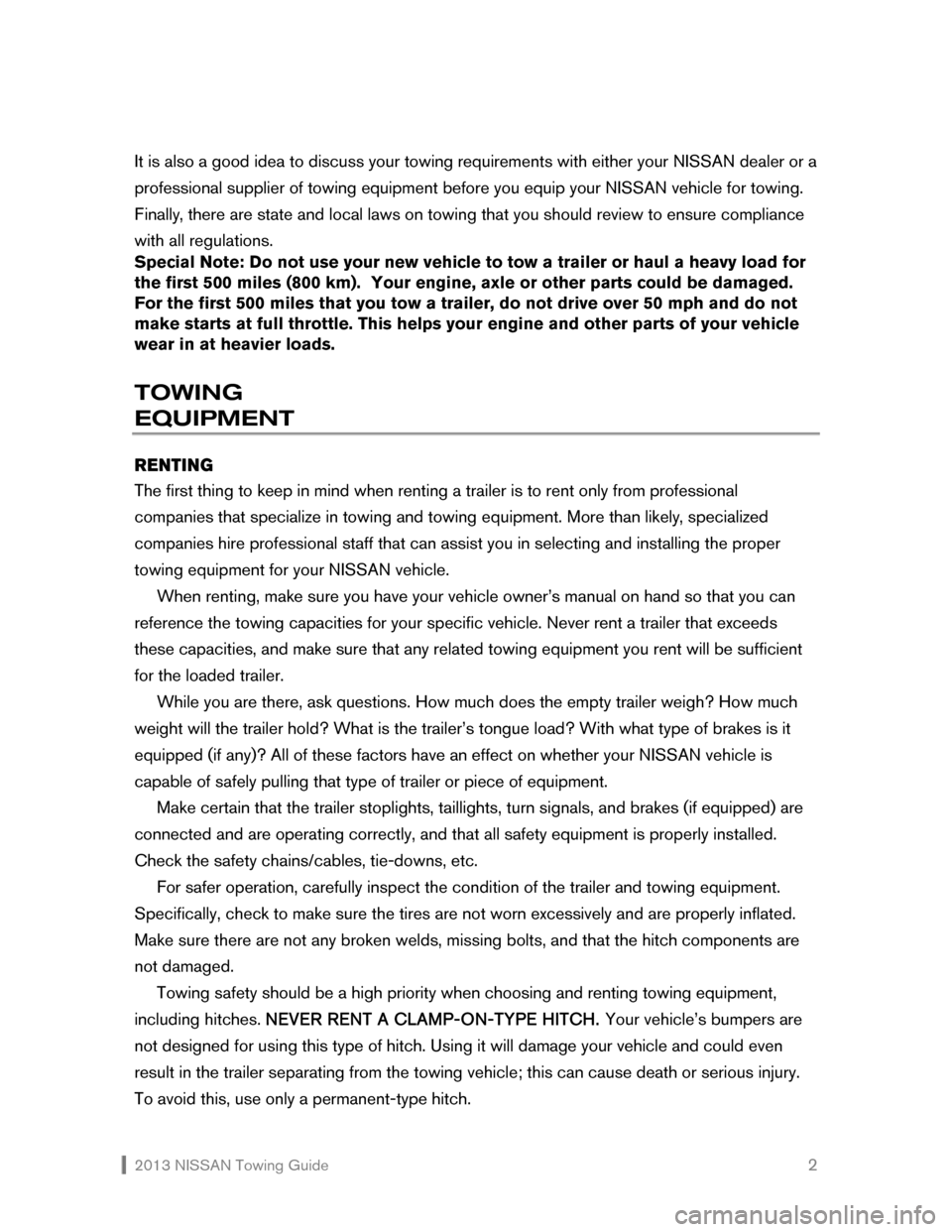
2013 NISSAN Towing Guide 2 It is also a good idea to discuss your towing requirements with either your NISSAN dealer or a
professional supplier of towing equipment before you equip your NISSAN vehicle for towing.
Finally, there are state and local laws on towing that you should review to ensure compliance
with all regulations.
Special Note: Do not use your new vehicle to tow a trailer or haul a heavy load for
the first 500 miles (800 km). Your engine, axle or other parts could be damaged.
For the first 500 miles that you tow a trailer, do not drive over 50 mph and do not
make starts at full throttle. This helps your engine and other parts of your vehicle
wear in at heavier loads.
TOWING
EQUIPMENT
RENTING
The first thing to keep in mind when renting a trailer is to rent only from professional
companies that specialize in towing and towing equipment. More than likely, specialized
companies hire professional staff that can assist you in selecting and installing the proper
towing equipment for your NISSAN vehicle.
When renting, make sure you have your vehicle owner’s manual on hand so that you can
reference the towing capacities for your specific vehicle. Never rent a trailer that exceeds
these capacities, and make sure that any related towing equipment you rent will be sufficient
for the loaded trailer.
While you are there, ask questions. How much does the empty trailer weigh? How much
weight will the trailer hold? What is the trailer’s tongue load? With what type of brakes is it
equipped (if any)? All of these factors have an effect on whether your NISSAN vehicle is
capable of safely pulling that type of trailer or piece of equipment.
Make certain that the trailer stoplights, taillights, turn signals, and brakes (if equipped) are
connected and are operating correctly, and that all safety equipment is properly installed.
Check the safety chains/cables, tie-downs, etc.
For safer operation, carefully inspect the condition of the trailer and towing equipment.
Specifically, check to make sure the tires are not worn excessively and are properly inflated.
Make sure there are not any broken welds, missing bolts, and that the hitch components are
not damaged.
Towing safety should be a high priority when choosing and renting towing equipment,
including hitches. NEVER RENT A CLAMP-ON-TYPE HITCH. Your vehicle’s bumpers are
not designed for using this type of hitch. Using it will damage your vehicle and could even
result in the trailer separating from the towing vehicle; this can cause death or serious injury.
To avoid this, use only a permanent-type hitch.
Page 6 of 27
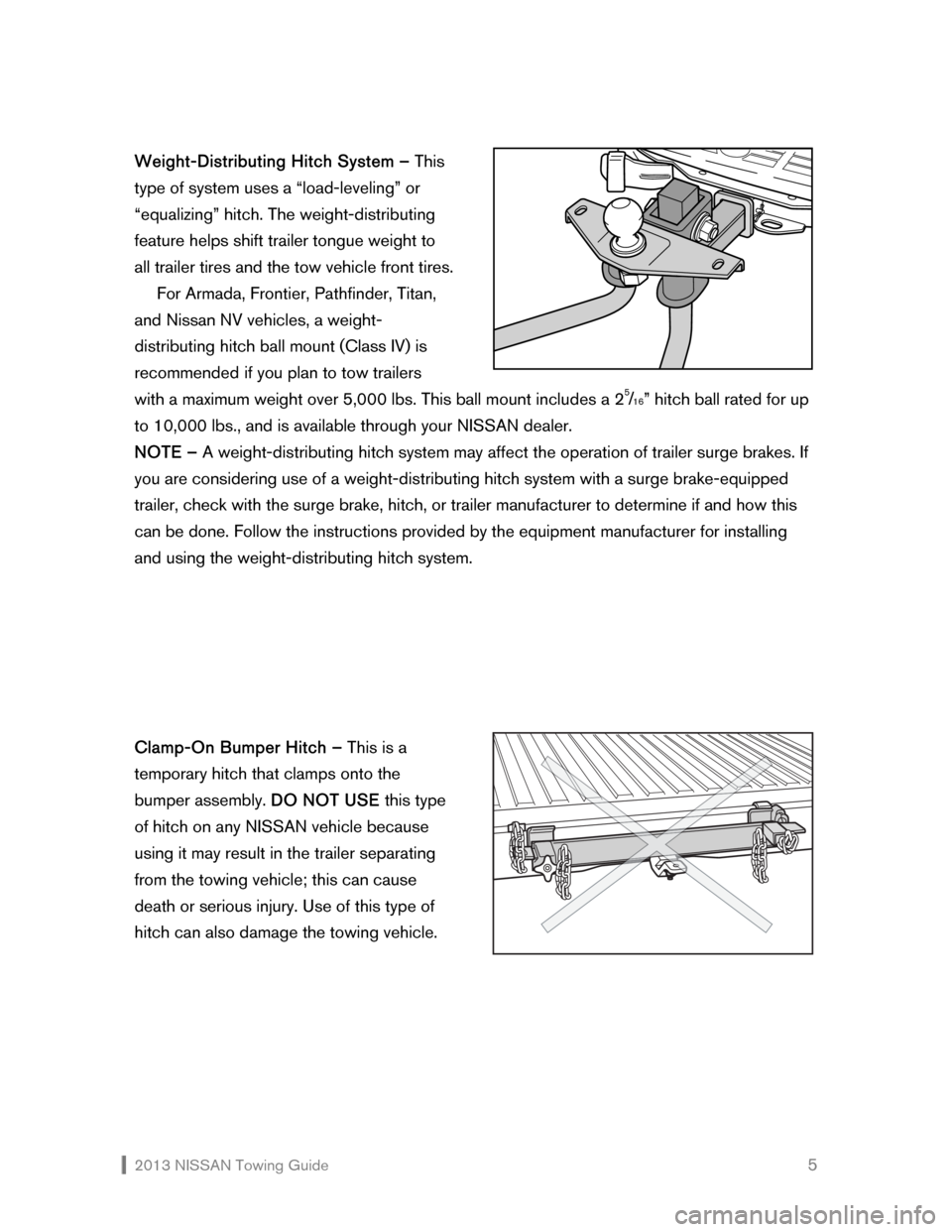
2013 NISSAN Towing Guide 5 Weight-Distributing Hitch System – This
type of system uses a “load-leveling” or
“equalizing” hitch. The weight-distributing
feature helps shift trailer tongue weight to
all trailer tires and the tow vehicle front tires.
For Armada, Frontier, Pathfinder, Titan,
and Nissan NV vehicles, a weight-
distributing hitch ball mount (Class IV) is
recommended if you plan to tow trailers
with a maximum weight over 5,000 lbs. This ball mount includes a 2
5/16” hitch ball rated for up
to 10,000 lbs., and is available through your NISSAN dealer.
NOTE – A weight-distributing hitch system may affect the operation of trailer surge brakes. If
you are considering use of a weight-distributing hitch system with a surge brake-equipped
trailer, check with the surge brake, hitch, or trailer manufacturer to determine if and how this
can be done. Follow the instructions provided by the equipment manufacturer for installing
and using the weight-distributing hitch system.
Clamp-On Bumper Hitch – This is a
temporary hitch that clamps onto the
bumper assembly. DO NOT USE this type
of hitch on any NISSAN vehicle because
using it may result in the trailer separating
from the towing vehicle; this can cause
death or serious injury. Use of this type of
hitch can also damage the towing vehicle.
Page 9 of 27
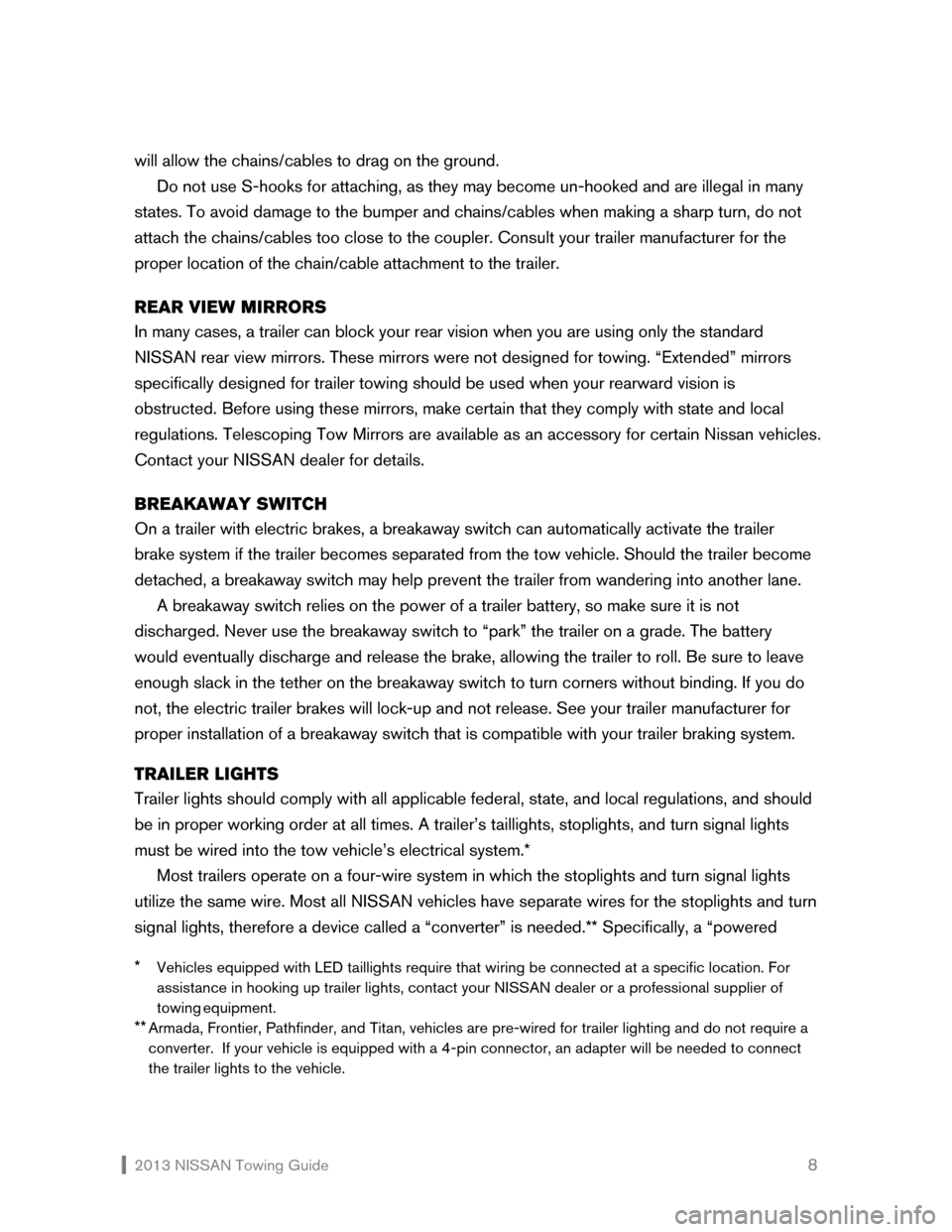
2013 NISSAN Towing Guide 8 will allow the chains/cables to drag on the ground.
Do not use S-hooks for attaching, as they may become un-hooked and are illegal in many
states. To avoid damage to the bumper and chains/cables when making a sharp turn, do not
attach the chains/cables too close to the coupler. Consult your trailer manufacturer for the
proper location of the chain/cable attachment to the trailer.
REAR VIEW MIRRORS
In many cases, a trailer can block your rear vision when you are using only the standard
NISSAN rear view mirrors. These mirrors were not designed for towing. “Extended” mirrors
specifically designed for trailer towing should be used when your rearward vision is
obstructed. Before using these mirrors, make certain that they comply with state and local
regulations. Telescoping Tow Mirrors are available as an accessory for certain Nissan vehicles.
Contact your NISSAN dealer for details.
BREAKAWAY SWITCH
On a trailer with electric brakes, a breakaway switch can automatically activate the trailer
brake system if the trailer becomes separated from the tow vehicle. Should the trailer become
detached, a breakaway switch may help prevent the trailer from wandering into another lane.
A breakaway switch relies on the power of a trailer battery, so make sure it is not
discharged. Never use the breakaway switch to “park” the trailer on a grade. The battery
would eventually discharge and release the brake, allowing the trailer to roll. Be sure to leave
enough slack in the tether on the breakaway switch to turn corners without binding. If you do
not, the electric trailer brakes will lock-up and not release. See your trailer manufacturer for
proper installation of a breakaway switch that is compatible with your trailer braking system.
TRAILER LIGHTS
Trailer lights should comply with all applicable federal, state, and local regulations, and should
be in proper working order at all times. A trailer’s taillights, stoplights, and turn signal lights
must be wired into the tow vehicle’s electrical system.*
Most trailers operate on a four-wire system in which the stoplights and turn signal lights
utilize the same wire. Most all NISSAN vehicles have separate wires for the stoplights and turn
signal lights, therefore a device called a “converter” is needed.** Specifically, a “powered
* Vehicles equipped with LED taillights require that wiring be connected at a specific location. For
assistance in hooking up trailer lights, contact your NISSAN dealer or a professional supplier of
towing
equipment.
** Armada, Frontier, Pathfinder, and Titan, vehicles are pre-wired for trailer lighting and do not require a
converter. If your vehicle is equipped with a 4-pin connector, an adapter will be needed to connect
the trailer lights to the vehicle.
Page 10 of 27
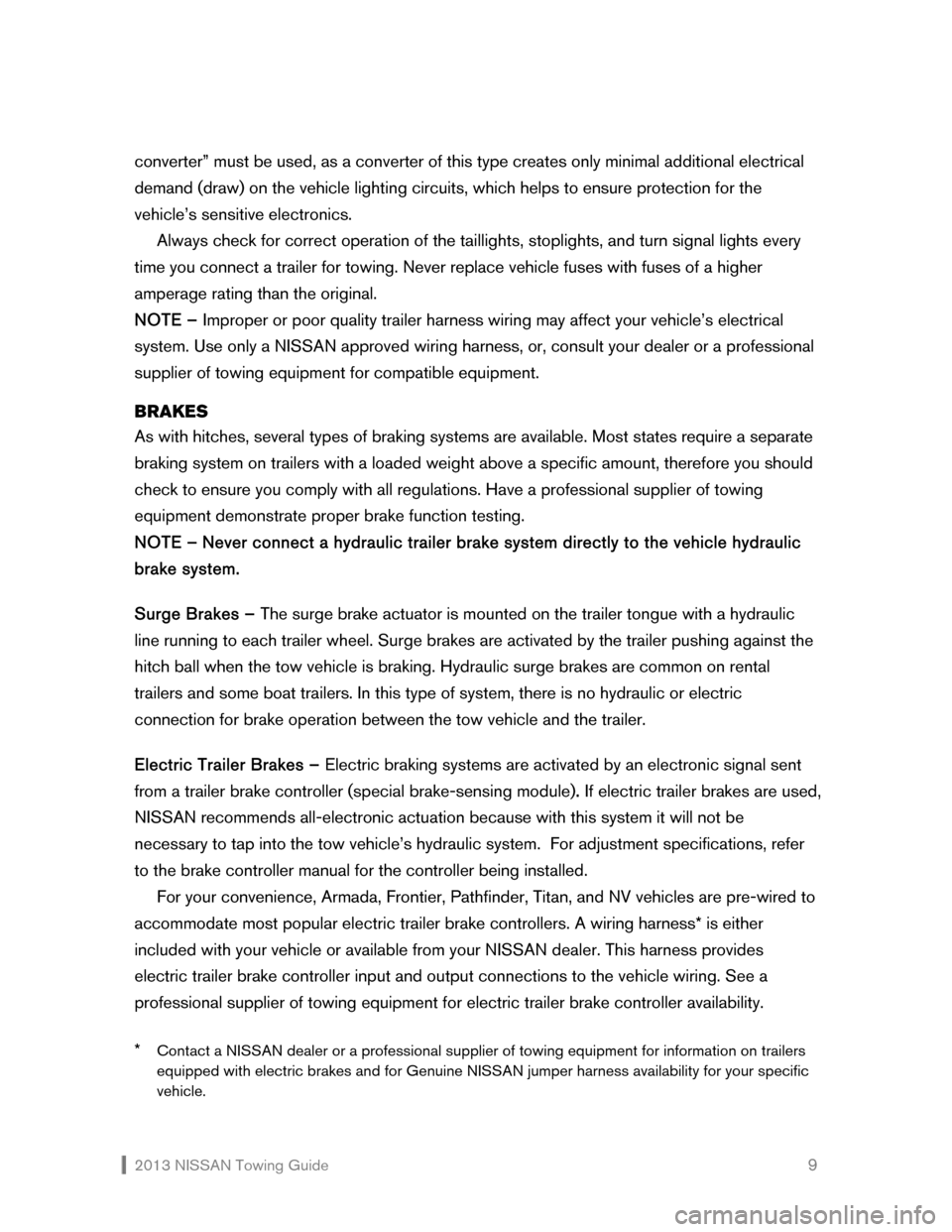
2013 NISSAN Towing Guide 9 converter” must be used, as a converter of this type creates only minimal additional electrical
demand (draw) on the vehicle lighting circuits, which helps to ensure protection for the
vehicle’s sensitive electronics.
Always check for correct operation of the taillights, stoplights, and turn signal lights every
time you connect a trailer for towing. Never replace vehicle fuses with fuses of a higher
amperage rating than the original.
NOTE – Improper or poor quality trailer harness wiring may affect your vehicle’s electrical
system. Use only a NISSAN approved wiring harness, or, consult your dealer or a professional
supplier of towing equipment for compatible equipment.
BRAKES
As with hitches, several types of braking systems are available. Most states require a separate
braking system on trailers with a loaded weight above a specific amount, therefore you should
check to ensure you comply with all regulations. Have a professional supplier of towing
equipment demonstrate proper brake function testing.
NOTE – Never connect a hydraulic trailer brake system directly to the vehicle hydraulic
brake system.
Surge Brakes – The surge brake actuator is mounted on the trailer tongue with a hydraulic
line running to each trailer wheel. Surge brakes are activated by the trailer pushing against the
hitch ball when the tow vehicle is braking. Hydraulic surge brakes are common on rental
trailers and some boat trailers. In this type of system, there is no hydraulic or electric
connection for brake operation between the tow vehicle and the trailer.
Electric Trailer Brakes – Electric braking systems are activated by an electronic signal sent
from a trailer brake controller (special brake-sensing module). If electric trailer brakes are used,
NISSAN recommends all-electronic actuation because with this system it will not be
necessary to tap into the tow vehicle’s hydraulic system. For adjustment specifications, refer
to the brake controller manual for the controller being installed.
For your convenience, Armada, Frontier, Pathfinder, Titan, and NV vehicles are pre-wired to
accommodate most popular electric trailer brake controllers. A wiring harness* is either
included with your vehicle or available from your NISSAN dealer. This harness provides
electric trailer brake controller input and output connections to the vehicle wiring. See a
professional supplier of towing equipment for electric trailer brake controller availability.
* Contact a NISSAN dealer or a professional supplier of towing equipment for information on trailers
equipped with electric brakes and for Genuine NISSAN jumper harness availability for your specific
vehicle.
Page 16 of 27
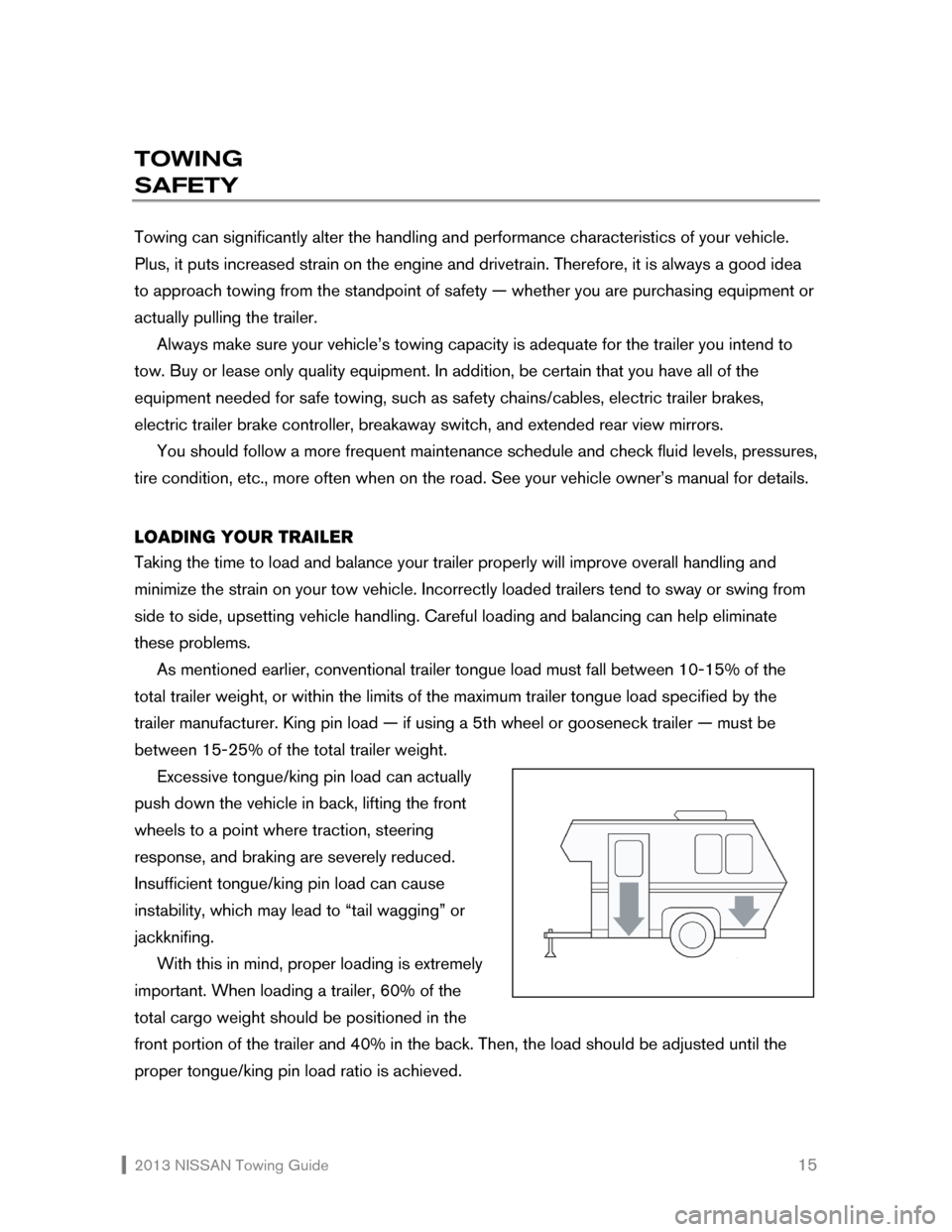
2013 NISSAN Towing Guide 15
TOWING
SAFETY
Towing can significantly alter the handling and performance characteristics of your vehicle.
Plus, it puts increased strain on the engine and drivetrain. Therefore, it is always a good idea
to approach towing from the standpoint of safety — whether you are purchasing equipment or
actually pulling the trailer.
Always make sure your vehicle’s towing capacity is adequate for the trailer you intend to
tow. Buy or lease only quality equipment. In addition, be certain that you have all of the
equipment needed for safe towing, such as safety chains/cables, electric trailer brakes,
electric trailer brake controller, breakaway switch, and extended rear view mirrors.
You should follow a more frequent maintenance schedule and check fluid levels, pressures,
tire condition, etc., more often when on the road. See your vehicle owner’s manual for details.
LOADING YOUR TRAILER
Taking the time to load and balance your trailer properly will improve overall handling and
minimize the strain on your tow vehicle. Incorrectly loaded trailers tend to sway or swing from
side to side, upsetting vehicle handling. Careful loading and balancing can help eliminate
these problems.
As mentioned earlier, conventional trailer tongue load must fall between 10-15% of the
total trailer weight, or within the limits of the maximum trailer tongue load specified by the
trailer manufacturer. King pin load — if using a 5th wheel or gooseneck trailer — must be
between 15-25% of the total trailer weight.
Excessive tongue/king pin load can actually
push down the vehicle in back, lifting the front
wheels to a point where traction, steering
response, and braking are severely reduced.
Insufficient tongue/king pin load can cause
instability, which may lead to “tail wagging” or
jackknifing.
With this in mind, proper loading is extremely
important. When loading a trailer, 60% of the
total cargo weight should be positioned in the
front portion of the trailer and 40% in the back. Then, the load should be adjusted until the
proper tongue/king pin load ratio is achieved.
Page 18 of 27
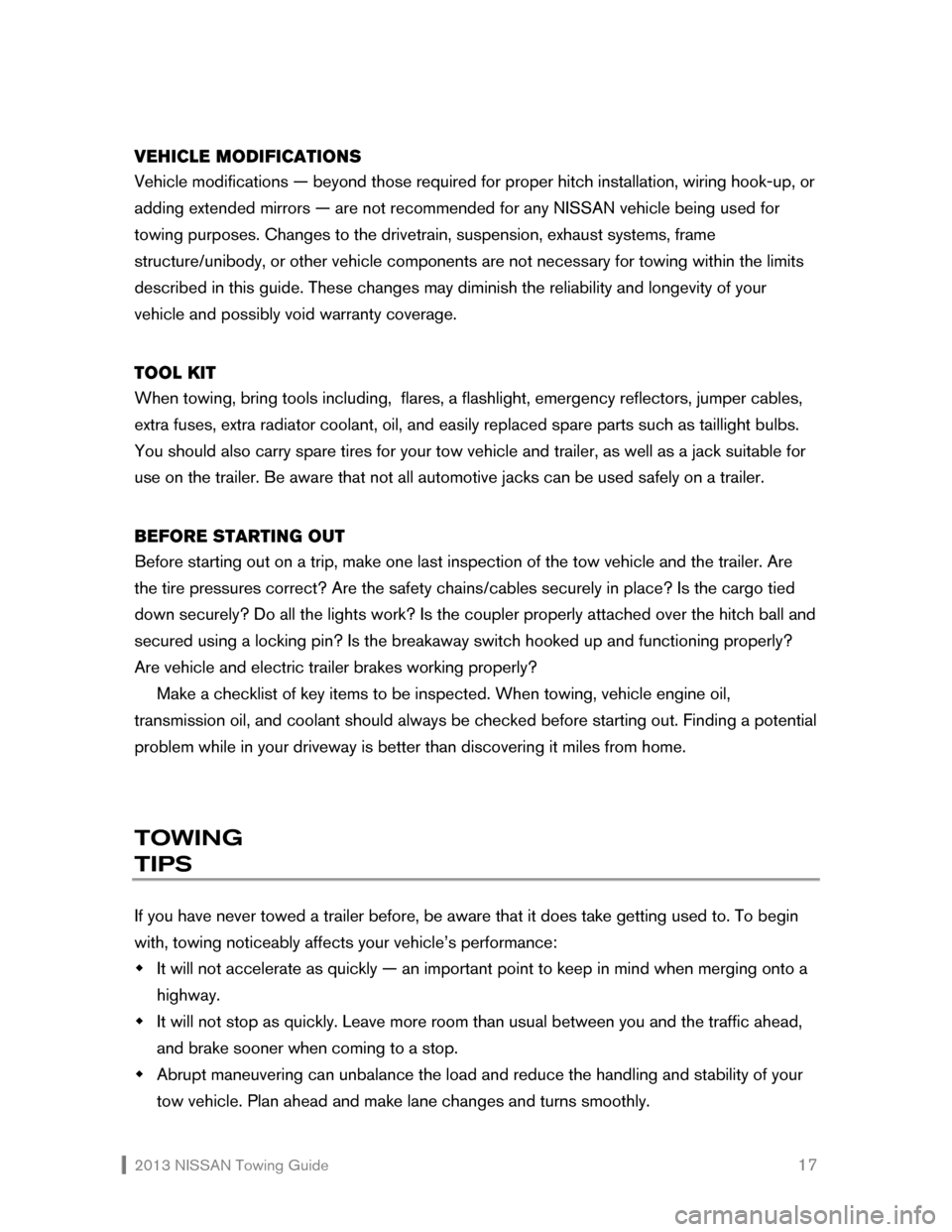
2013 NISSAN Towing Guide 17 VEHICLE MODIFICATIONS
Vehicle modifications — beyond those required for proper hitch installation, wiring hook-up, or
adding extended mirrors — are not recommended for any NISSAN vehicle being used for
towing purposes. Changes to the drivetrain, suspension, exhaust systems, frame
structure/unibody, or other vehicle components are not necessary for towing within the limits
described in this guide. These changes may diminish the reliability and longevity of your
vehicle and possibly void warranty coverage.
TOOL KIT
When towing, bring tools including, flares, a flashlight, emergency reflectors, jumper cables,
extra fuses, extra radiator coolant, oil, and easily replaced spare parts such as taillight bulbs.
You should also carry spare tires for your tow vehicle and trailer, as well as a jack suitable for
use on the trailer. Be aware that not all automotive jacks can be used safely on a trailer.
BEFORE STARTING OUT
Before starting out on a trip, make one last inspection of the tow vehicle and the trailer. Are
the tire pressures correct? Are the safety chains/cables securely in place? Is the cargo tied
down securely? Do all the lights work? Is the coupler properly attached over the hitch ball and
secured using a locking pin? Is the breakaway switch hooked up and functioning properly?
Are vehicle and electric trailer brakes working properly?
Make a checklist of key items to be inspected. When towing, vehicle engine oil,
transmission oil, and coolant should always be checked before starting out. Finding a potential
problem while in your driveway is better than discovering it miles from home.
TOWING
TIPS
If you have never towed a trailer before, be aware that it does take getting used to. To begin
with, towing noticeably affects your vehicle’s performance:
�Š It will not accelerate as quickly — an important point to keep in mind when merging onto a
highway.
�Š It will not stop as quickly. Leave more room than usual between you and the traffic ahead,
and brake sooner when coming to a stop.
�Š Abrupt maneuvering can unbalance the load and reduce the handling and stability of your
tow vehicle. Plan ahead and make lane changes and turns smoothly.
Page 19 of 27
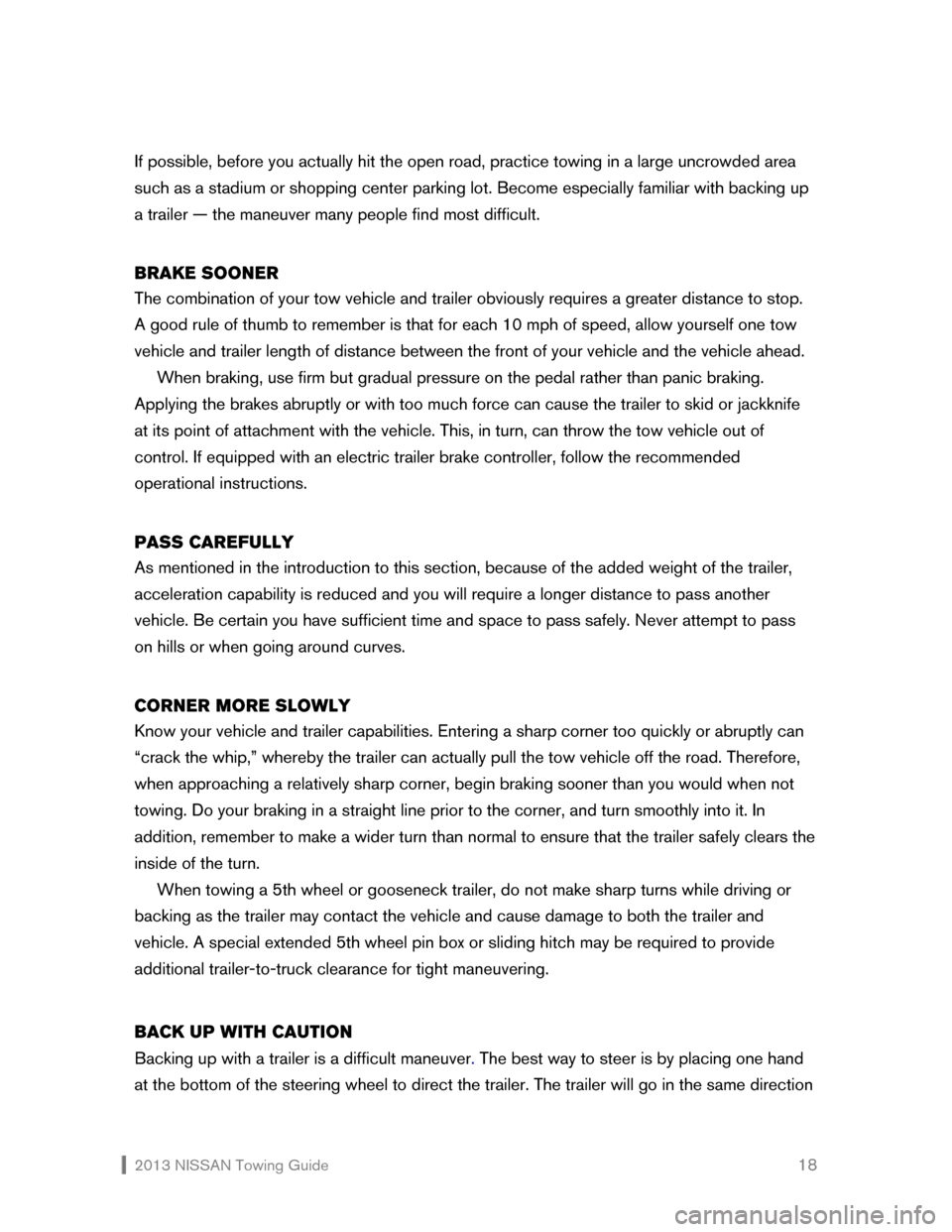
2013 NISSAN Towing Guide 18 If possible, before you actually hit the open road, practice towing in a large uncrowded area
such as a stadium or shopping center parking lot. Become especially familiar with backing up
a trailer — the maneuver many people find most difficult.
BRAKE SOONER
The combination of your tow vehicle and trailer obviously requires a greater distance to stop.
A good rule of thumb to remember is that for each 10 mph of speed, allow yourself one tow
vehicle and trailer length of distance between the front of your vehicle and the vehicle ahead.
When braking, use firm but gradual pressure on the pedal rather than panic braking.
Applying the brakes abruptly or with too much force can cause the trailer to skid or jackknife
at its point of attachment with the vehicle. This, in turn, can throw the tow vehicle out of
control. If equipped with an electric trailer brake controller, follow the recommended
operational instructions.
PASS CAREFULLY
As mentioned in the introduction to this section, because of the added weight of the trailer,
acceleration capability is reduced and you will require a longer distance to pass another
vehicle. Be certain you have sufficient time and space to pass safely. Never attempt to pass
on hills or when going around curves.
CORNER MORE SLOWLY
Know your vehicle and trailer capabilities. Entering a sharp corner too quickly or abruptly can
“crack the whip,” whereby the trailer can actually pull the tow vehicle off the road. Therefore,
when approaching a relatively sharp corner, begin braking sooner than you would when not
towing. Do your braking in a straight line prior to the corner, and turn smoothly into it. In
addition, remember to make a wider turn than normal to ensure that the trailer safely clears the
inside of the turn.
When towing a 5th wheel or gooseneck trailer, do not make sharp turns while driving or
backing as the trailer may contact the vehicle and cause damage to both the trailer and
vehicle. A special extended 5th wheel pin box or sliding hitch may be required to provide
additional trailer-to-truck clearance for tight maneuvering.
BACK UP WITH CAUTION
Backing up with a trailer is a difficult maneuver. The best way to steer is by placing one hand
at the bottom of the steering wheel to direct the trailer. The trailer will go in the same direction